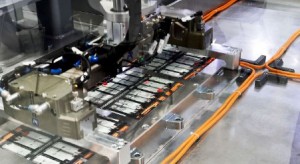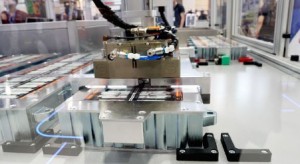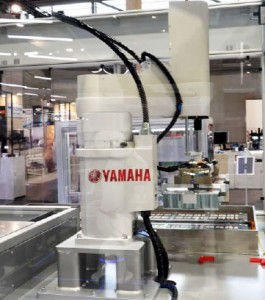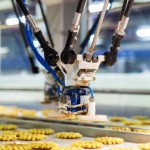Automating end-of-line battery test and assembly
 The experts at Yamaha explain that SCARA robots can bring fast and flexible automation to automotive battery production, providing a platform for accurate, high-speed handling of battery modules for end-of-line testing and assembly.
The experts at Yamaha explain that SCARA robots can bring fast and flexible automation to automotive battery production, providing a platform for accurate, high-speed handling of battery modules for end-of-line testing and assembly.
Sales of electric vehicles are growing, as new styles are offered and usability and driving range improve. With environmental legislation putting its weight behind the category, the market is heading towards more EVs and calling for greater affordability. By increasing production, hence delivering more vehicles and at the same time becoming able to leverage economies of scale, car makers can satisfy both requirements.
Manufacturing in volume is a known skill of the automotive industry. There is now a demand to build large numbers of batteries of the appropriate power and capacity for EVs – up to and over 100 kWh.
Quality, scale and economy
New battery factories are springing up to satisfy the growing demand for large batteries, coming not only from the automotive industry but other green-energy projects too – such as grid-connected storage.
Driving automation through the entire process from end to end is consistent with the battery companies’ aims to increase volume, leverage economies of scale, and ensure repeatability leading to consistent quality. This is needed to maximise battery capacity and performance such as driving range, which has a powerful influence on customer perception. Quality is also critical to ensure the safety of the battery.
The factories are often vast, to handle the sheer volume of the large-scale energy storage in continuous production. Autonomous guided vehicles (AGVs) are used extensively to transport heavy materials and components for long distances, while custom automation and articulated robots are extensively deployed to handle processes such as preparing the active components, attaching electrodes, assembling cells, and building modules and battery packs.
 As the cells are combined to make modules, and modules are built into battery packs, production processes typically involve picking up components and placing them with precision, ready for electrical connections to be added. This may be done manually or using other automated equipment.
As the cells are combined to make modules, and modules are built into battery packs, production processes typically involve picking up components and placing them with precision, ready for electrical connections to be added. This may be done manually or using other automated equipment.
Through each successive stage, the assembly becomes larger and heavier. A complete prismatic EV battery module can be 30-40kg, which challenges process engineers to automate the handling, testing, and packaging of these modules at the end of the battery production line.
Accurate placement is extremely important during end-of-line testing, to align the module terminals correctly with electrical connections of the test fixture. Subsequently, transferring the module from the test fixture into the battery pack ready for final electrical connections to be made also calls for high accuracy. Speed is also of the essence, to maintain high productivity.
Accurate, affordable automation
SCARA robots are in the market that combine high payload capacity with high-speed, controlled motion that can position items accurately within 0.05mm in the x-y plane and to within 20 micron (20µm) in the z-axis. These can provide a cost-effective and technically mature solution to the challenge of moving and positioning large, heavy battery components such as prismatic lithium-ion cells. An example is the Yamaha YK1200X series, a standard SCARA robot that has payload capacity up to 50kg and is capable of moving items at up to 7.5m/s in x-y axis.
The Yamaha YK1200X has been chosen to create the Heavy Exact Rapid Operator (HERO), a prismatic battery module handling solution that enables full automation of the end-of-line testing and battery-pack assembly processes. The demonstration shows how the combination of Yamaha’s SCARA with custom technology can raise, move, and position the 35kg modules at high speed and with high accuracy to boost the productivity of these processes.
In the lifting solution created specifically for the battery module application, engaging with each of the four lifting points on the outside of the module casing, the lifter allows the module to be securely raised, moved, and rotated through up to 360 degrees, if necessary, to ensure the correct positioning and orientation.
Modules that pass the tests are removed from the test fixture and placed in their final positions in the battery pack, ready for electrical wiring and final assembly of the pack.
The requirements for end-of-line automation can vary considerably between different battery makers, different battery pack designs, and different vehicle types. The modules may need to be positioned precisely in relation to electrical terminal pins of a test fixture, or in the final battery pack assembly.
On the other hand, human workers may be responsible for installing circuit boards such as the battery management system (BMS), installing cabling and electrical connections, and closing and sealing the battery casing at the final assembly stage. SCARA-based automation can support any of these approaches.
 Use of floorspace
Use of floorspace
Taking advantage of the long reach of the YK1200X, which has 1.2-metre arm length, the handling solution demonstrates how any battery modules that fail electrical tests can be isolated from the battery manufacturing process and placed in a separate area for further investigation and repair.
While the extended reach allows flexibility to move the modules to any of three distinct locations, for testing, assembly, and repair, SCARA kinematics enable this to be accomplished within a compact space that occupies only a few square metres. A large battery factory could accommodate several such assembly cells if required and add more at any time in the future to further increase production volume if needed.
Highly automated battery factories are an important enabler for the transition to electric mobility. Raising output and productivity holds the key to delivering the large numbers of electric vehicles needed, at prices that are affordable for the mass market. Standard automation, such as the proven and mature SCARA robot, could be a cost-effective option, assuming adequate payload capacity and reach to handle end-of-line processes.
Automotive battery makers can take advantage of the speed and flexibility of existing Yamaha industrial robots to pick and place heavy battery modules at high speed and with high precision at the end of the production line.
Visit the Yamaha website for more information
















